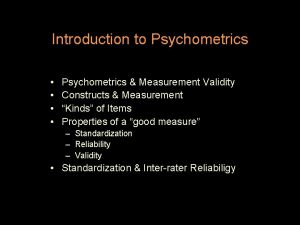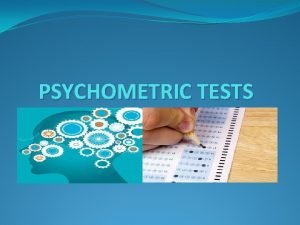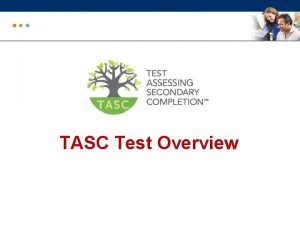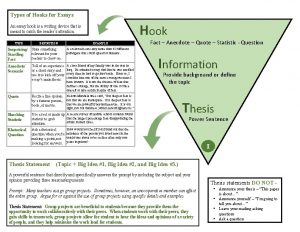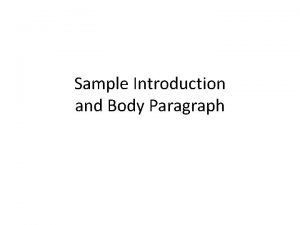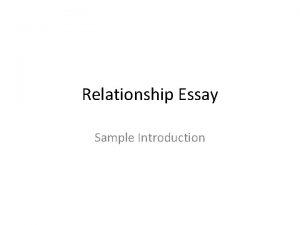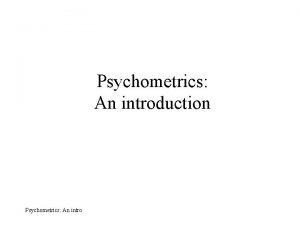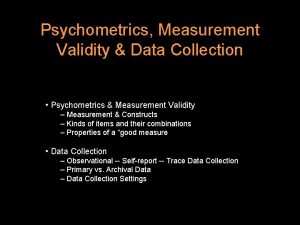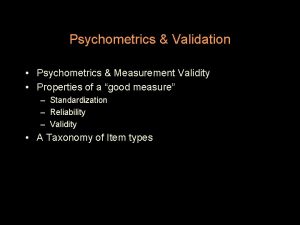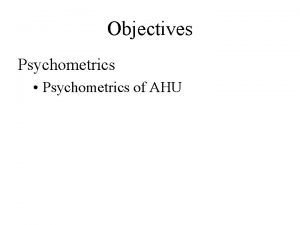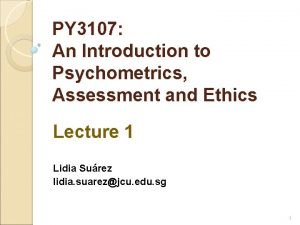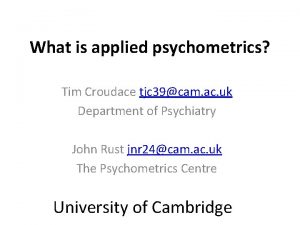Psychometrics An introduction Psychometrics An intro Overview A























- Slides: 23

Psychometrics: An introduction Psychometrics: An intro

Overview • • A brief history of psychometrics The main types of tests The 10 most common tests Why psychometrics? : Clinical versus actuarial judgment Psychometrics: An intro

A brief history • Testing for proficiency dates back to 2200 B. C. , when the Chinese emperor used grueling tests to assess fitness for office Psychometrics: An intro

Francis Galton • Modern psychometrics dates to Sir Francis Galton (18221911), Charles Darwin’s cousin • Interested in (in fact, obsessed with) individual differences and their distribution • 1884 -1890: Tested 17, 000 individuals on height, weight, sizes of accessible body parts, + behavior: hand strength, visual acuity, RT etc • Demonstrated that objective tests could provide meaningful scores Psychometrics: An intro

James Cattell • James Cattell �(studied Wundt with & Galton) first used the term ‘mental test’in 1890 • His tests were in the ‘brass instruments’ tradition of Galton • mostly motor and acuity tests • Founded ‘Psychological Review’(1897) Psychometrics: An intro

Clark Wissler • Clark Wissler (Cattell’s student) did the first basic validational research, examining the relation between the old ‘mental test’ scores and academic achievement • His results were largely discouraging • He had only bright college students in his sample • Why is this a problem? • Wissler became an anthropologist with a strong environmentalist bias. Psychometrics: An intro

Alfred Binet • Goodenough (1949): The Galtonian approach was like “inferring the nature of genius from the nature of stupidity or the qualities of water from those of…. hydrogen and oxygen”. • Alfred Binet (1905) introduced the first modern intelligence test, which directly tested higher psychological processes (real abilities & practical judgments) • i. e. picture naming, rhyme production, weight ordering, question answering, word definition. • Also motivated IQ (Stern, 1914): mental ‘age’ divided by chronological age Psychometrics: An intro

The rise of psychometrics • Lewis Terman (1916) produced a major revision of Binet’s scale • Robert Yerkes (1919) convinced the US government to test 1. 75 million army recruits • Post WWI: Factor analysis emerged, making other aptitude and personality tests possible Psychometrics: An intro

What is a psychometric test? • A test is a standardized procedure for sampling behavior and describing it using scores or categories – Most tests are predictive of of some non-test behavior of interest – Most tests are norm-referenced = they describe the behavior in terms of norms, test results gathered from a large group of subjects (the standardization sample) – Some tests are criterion-referenced = the objective is to see if the subject can attain some pre-specified criterion. Psychometrics: An intro

The main types of tests • • Intelligence tests: Assess intelligence Aptitude tests: Assess capability Achievement tests: Assess degree of accomplishment Creativity tests: Assess capacity for novelty Personality tests: Assess traits Interest inventories: Assess preferences for activities Behavioral tests: Measure behaviors and their antecedents/consequences • Neuropsychological tests: Measure cognitive, sensory, perceptual, or motor functions Psychometrics: An intro

The 10 most commonly used tests 1. ) Wechsler Intelligence Scale for Children (WISC) 2. ) Bender Visual-Motor Gestalt Test 3. ) Wechsler Adult Intelligence Scale (WAIS) 4. ) Minnesota Multiphasic Personality Inventory (MMPI) 5. ) Rorschach Ink Blot Test 6. ) Thematic Apperception Test (TAT) 7. ) Sentence Completion 8. ) Goodenough Draw-A-Person Test 9. ) House-Tree-Person Test 10. ) Stanford-Binet Intelligence Scale From Brown & Mc. Guire, 1976 Psychometrics: An intro

Clinical versus actuarial judgment • Clinical judgment = reaching a decision by processing information in ones head • Actuarial judgment = reaching a decision without employing human judgment, using empirically-established relations between data and the event of interest – ‘Actuarial’: ad. L. actu [{amac}] ri-us, a keeper of accounts – Note that some of the data in an actuarial judgment may be qualitative clinical observations, allowing a mixture of methods Psychometrics: An intro

Clinical versus actuarial judgment • Paul Meehl (1954) first addressed the question: Which is better? • His ground rules for comparison: – Both methods should draw from the same data set (this was relaxed by others, with no changes in results) – Cross-validation should be required, to avoid using variation specific to the data set – There should be explicit prediction of success, recidivism, or recovery Psychometrics: An intro

Meehl (1954): Results • He looked at between 16 and 20 studies (depending on inclusion criteria) “…it is clear that the dogmatic, complacent assertion sometimes heard from clinicians that ‘naturally’ clinical prediction, being based on ‘real understanding’ is superior, is simply not justified by the facts to date”. • In all but one case, predictions made by actuarial means were equal to or better than clinical methods – In a later paper, he changed his mind about the one. Psychometrics: An intro

Thirty years later. . . “There is no controversy in social science that shows such a large body of qualitatively diverse studies coming out so uniformly as this one. ” Paul Meehl, 1986 Psychometrics: An intro

Where are clinician’s strengths? I i. ) Theory-mediated judgments – If the predictor knows the relevant causal influences, can measure them, and has a model specific enough to take him/her from theory to fact – However, are there any reasons to doubt this potential advantage? Psychometrics: An intro

Where are clinician’s strengths? II ii. ) Ability to use rare events – If the predictor knows that the current case is an exception to the statistical trend, s/he can use that information to over-ride the trend – it is in theory possible to build these into actuarial methods • Why is it very difficult in practice? • Why might we worry about clinicians ability to incorporate rare events into prediction? Psychometrics: An intro

Where are clinician’s strengths? III iii. ) Able to detect complex predictive cures - Humans beings still (for now) are masters at recognizing some complex configurations, such as facial expressions etc. Psychometrics: An intro

Where are clinician’s strengths? IV iv. ) Able to re-weight utilities in real-time - For ethical, legal, or humanitarian reasons, we might decide to do things differently than usual in particular cases. Psychometrics: An intro

Where actuarial strengths? I i. ) Immunity from fatigue, forgetfulness, hang -overs, hostility, prejudice, ignorance, false association, over-confidence, bias, and random fluctuations in judgment. Psychometrics: An intro

Where actuarial strengths? II ii. ) Consistency & proper weighting - variables are weighted the same way every time, according to their actual demonstrable contributions to the criterion of interest - irrelevant variables are properly weighted to zero Psychometrics: An intro

Where actuarial strengths? III iii. ) Feedback & base-rates ‘built-in’ to the system - Clinicians rarely know how they are doing because they don’t get immediate feedback and because they have imperfect memory - actuarial records constitute perfect memories of how things came out in similar cases and can include a larger and wider sample than a human can ever hope to see Psychometrics: An intro

Where actuarial strengths? IV iv. ) Not overly sensitive to optimal weightings - Even simplistic actuarial judgments often beat human judgments Psychometrics: An intro
 Introduction to psychometrics
Introduction to psychometrics Introduction to psychometric
Introduction to psychometric Tasc distinguished achievement
Tasc distinguished achievement Psychometrics 101
Psychometrics 101 Passmore psychometrics in coaching download
Passmore psychometrics in coaching download What is bioinformatics an introduction and overview
What is bioinformatics an introduction and overview Papercut job tickerting print software
Papercut job tickerting print software Introduction product overview
Introduction product overview Introduction product overview
Introduction product overview Introduction product overview
Introduction product overview Examples of thematic essays
Examples of thematic essays Introduction
Introduction Types of hooks in english
Types of hooks in english Hook in a paragraph
Hook in a paragraph Introduction to a comparative essay
Introduction to a comparative essay Introduction body and conclusion
Introduction body and conclusion Intro qr codes
Intro qr codes States of matter
States of matter Advertisement intro
Advertisement intro Tillbaka till vintergatan intro
Tillbaka till vintergatan intro Intro body conclusion example
Intro body conclusion example Reverse engineering basics
Reverse engineering basics Example of introduction title
Example of introduction title Parts of research paper
Parts of research paper
